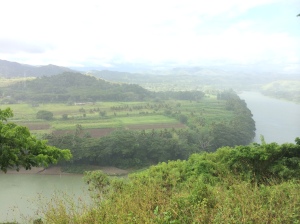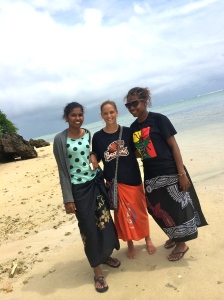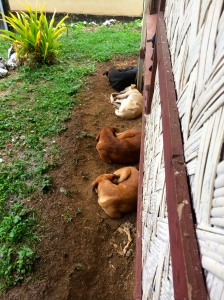Monday morning I went out to a nearby harbor for my Marine Pollution class to test the sedimentology. Our test sites were about a mile from the coast of the city’s sewage treatment plant so unsurprisingly the materials we managed to collect from the seafloor were piles of sludge (ew). I thought it was pretty hilarious though when were being separated into three different boats and the instructors organized that based on which students were the best swimmers. Our predeparture instructions consisted of how to properly wear our life jackets and what to do if/when the boat sinks. Luckily though we didn’t end up having any problems.
Thursday afternoon I left for my first field trip of the semester for my Resource Conservation and Management Class. All field trips are (unfortunately) supposed to be scheduled over spring break however this one got moved so now I only have one for the first half of break. Our first stop was at Tavuni Hill- where apparently some Tongan Chief hid in a fort from Fijian Warfare a long time ago. Unfortunately though when the Europeans entered Fiji in the early 1800’s the place was knocked down, so only rocks remained. So we spent about an hour wandering around this place with not really anything to see and I still have yet to understand the correlation between this destination and resource conservation. Right as we got there too it started to downpour, which we later learned was the beginning of a tropical depression (cyclone).
We took the bus to Cuvu Village from there where we spent the next two nights. We joined in on the opening Kava ceremony still drenched before we were allowed to go change, and some students even had to take a test for another class.
The reason our professor chose this village to take us to is because it is apart of a program that supports Marine Protected Areas- or MPA’s. These are areas in the ocean that have been deemed “dead zones” because all the coral has died from pollution. Then new corals are planted and fishing laws are implemented around the areas- such as no nets, overfishing, or poisons. There is an island resort about 500 meters across the beach from the village, and they pay for the MPA’s, and in return attract more tourists. The villagers patrol and set standards for the MPA’s, and in return yield more fish. We were originally supposed to tour the resort and MPA areas for the field trip however because of the depression we weren’t allowed to enter. So instead we spent the day interviewing the villagers about their take on the MPA’s and how it has impacted them.
The night ended with a huge Kava ceremony and plenty of dancing from the Solomon Island boys in the class as well as the Fijian girls. I got dragged into the Fijian dance but surprisingly didn’t do too bad (at least in my opinion). The whole trip ended up being a lot of fun and really helped me get to know a lot of my classmates better.
The following night I was back in Suva and went downtown to watch some of the Rugby matches. Fiji was playing that night and it was quite a sight seeing about 75 people hanging around the McDonalds trying to watch the one TV they had in the back corner. Fiji ended up wining that night, but I haven’t been able to keep up with them since.



